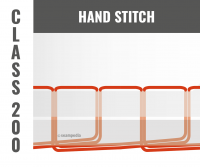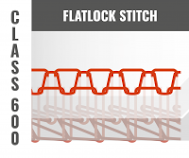STITCH CLASSIFICATION - VARIOUS TYPES OF STITCHES USED
IN GARMENT MAKING
In the fabric arts, a stitch is a single flip or loop of thread, or yarn. Stitches are the essential factors of sewing, knitting, embroidery, crochet, and needle lace-making, whether or not through hand or machine. A kind of stitches, every with one or more names, are used for specific purposes.
Loop or loops of one or more threads when bounds with each other by interlacing, interlocking, interlooping or intralooping or any combination during sewing. Then each unit of such structure (Seam) is called stitch.
Ø INTERLOOPING
Passing of a loop of
thread through another loop formed by the different thread.
Ø INTRALOOPING
Passing of a loop of
thread through another loop • formed by the same thread.
Ø INTERLACING
Passing of a thread over
or around another thread or loop of different thread.
STITCH CLASSIFICATION/STITCH TYPES
There are 70 types of stitches. Among them 18 to 20 types of stitches are widely used in garments industries.
Stitches are divided into 6 classes:
1. Stitch
class-100 (Single Needle Chain Stitch)
2. Stitch
class-200 (Hand Stitch)
3. Stitch
class-300 (Lock Stitch)
4. Stitch
class-400 (Multithread Chain Stitch)
5. Stitch
class-500 (Over edge Stitch)
6. Stitch
class-600 (Covering Chain Stitch)
STITCH CLASS – 100 (SINGLE THREAD CHAIN STITCH)
·
Single thread chain stitches are formed by
intralooping. – One or more needle thread is used for stitch formation.
·
A thread is passed through the fabric by the needle
and loop is prepared which is bound with the previous loop made by the same
needle.
·
Starting
and finishing end of the stitch under this class needs bar taking or back
stitching to secure the stitches.
·
Most
common uses in blind stitching, hemming, button attaching, button holing,
gathering, temporary positioning of garment components, etc.
·
In this way row of stitch is made. – This type of
stitch includes stitch type-101, 103 etc.
APPLICATIONS :
ü Used in lap
and flap positioning, temporary joining, positioning, basting, hemming, blind
stitching, button holing, button attaching purposes.
DISADVANTAGES :
ü Security of
stitch is very poor. If one end of the thread is pulled, then the whole sewing
will be opened.
STITCH CLASS – 200 (HAND STITCH)
·
Hand stitch is the stitch looks as if home hand stitch.
·
It is made by unique sort of needle and stitching device, that's known as pick stitch sewing machine.
·
Needle thread is handed from one side to every other side in the material and makes a sewn line.
·
They are used mainly for coat manufacturing.
APPLICATIONS :
ü Used in lapel
of jacket, coat and expensive clothes.
ü Stitch
type-209 is used for edge of the jacket.
DISADVANTAGES :
ü Time consuming
operation.
ü Speed of
sewing is very slow.
ü Higher cost.
ü Rare in use.
STITCH CLASS – 300 (LOCK STITCH)
·
Two or extra units of threads are used on this elegance of stitch.
·
One set of thread is known as needle thread and every other set is known as bobbin thread.
·
Here one set of threads are interlaced with every other set of thread and make bond.
·
Fine yarn is optimal for this type of stitching.
·
Stitch type 301 is the maximum common amongst three hundred elegance.
·
General functions are stitching, becoming a member of one of a kind additives at some stage in clothes making, top stitching etc.
APPLICATIONS :
ü
Extensively used in sewing and fabric attachment as
pocket, collar, cuff, facing etc.
ü
Also used in top stitching, button holing, button
attaching, blind stitching etc.
ü
Stitch type 304 is zigzag type, used for attaching
lace, elastic and so on.
ADVANTAGES:
ü
Stitches are secured, higher strength and
extensibility (around 30%).
ü
Both side of this stitch looks same.
ü
More secured stitch than chain stitch.
DISADVANTAGES:
ü The main
problem of lock stitch is the lower capacity of bobbin thread requires frequent
bobbin thread changing.
ü Not suitable
for knit fabric sewing.
STITCH CLASS – 400 (MULTI THREAD CHAIN STITCH)
·
Stitches are shaped by two or extra set of threads.
· One set of thread is known as needle thread and every other set is known as looper thread.
· The loop of 1 set thread is handed through the material and bound with every other set of thread by interlacing and interlooping.
·
Stitch kind 401 is the maximum not unusualplace amongst four hundred elegance.
·
The the front side of the stitch is looks like lock stitch and the lower back side is visible as double chain.
·
Sometimes this sort of chain stitch is known as double locked stitch, due to the fact one needle thread is bound with loops of the lower thread.
APPLICATIONS :
ü
Stitch type-401 is used for long sewing in the
jeans and trousers. Also this type of stitch is used with over edge stitch.
ü
Stitch type-406,407 is used for joining lace,
braid, elastic with the garments.
ADVANTAGES:
ü
Strength of 401 is higher than 301.
ü
Less possibility of producing seam pucker.
ü
Extensibility is same as Lock stitch.
ü
Chain stitch can be made by comparatively less
tension of thread, so that this classes of stitch is produced with high speed.
ü
SPM of chain stitch machine is 8000, where SPM of
lock stitch machine is 6000.
DISADVANTAGES:
ü Lower
resistance to runback and have increase the bulk under the seam.
STITCH CLASS – 500 (OVER EDGE STITCH)
·
This type of stitch is made by one or extra units of thread and is bound by minimal loops of 1 set of thread by rotating the fabric edge. As a end result thread can not be drawing off from the fabric edge.
·
Before stitching, the material part is wiped clean by the knife of the machine that's positioned at the front of the needle.
·
Sometime it is known as over locking machine, however it is specially over edge stitch.
·
Width of stitch may vary from three to five mm.
·
Width of stitch may vary from 3 to 5 mm.
·
Sometimes it is used for decorative
purpose. Extensibility is quite well (may be 300%)
·
Stitch type-504 is the most common. Stitch type-503, 512, 514 also
positioned in this category.
APPLICATIONS:
ü Stitch type-504 is used for decoration of fabric
end.
ü It is also used in combination with lock stitch and
chain stitch. » For light fabric stitch type-512 is used.
ü For coarse fabric such as denim, jeans, cord stitch
type-514 is used.
ADVANTAGES:
ü Extensibility is higher ( up to 30%).
DISADVANTAGES:
ü This stitch type is prone to seam grinning (the
threads are exposed when the seam is pulled at right angles to the line of
sewing).
ü The finish may be somewhat bulky due to the complexity
of the seam construction.
STITCH CLASS – 600 (COVERING CHAIN STITCH)
· Stitches under six hundred elegance are shaped by 3 units of threads.
·
First set of thread is known as needle thread, 2nd set of thread is known as top cover thread and 1/3 set of thread is known as bottom cover thread.
·
Stitch type-602 is the most common.
·
This type of stitch is used for sewing underwear, for
attaching lace, braid, elastic, etc.
·
It is also used for making cover stitch, decorative stitch
and top stitching.
APPLICATIONS:
ü
Stitch type-602 is used for attaching tape, lace,
braid, elastic to knit fabric.
ü
Stitch type-606 is used for making knitted
undergarments. It is also used for decorative purpose.
ü
For making cover stitch, top stitching in the
fabric edge this type is also used.
DISADVANTAGES:
ü Stitches under
this group are very complex and may need up to 9 threads.















Comments
Post a Comment